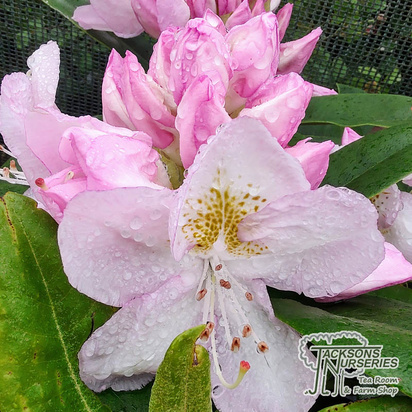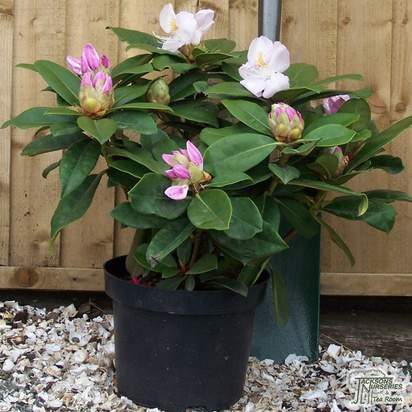This is a lovely, spreading evergreen variety with distinctively thick, deep green leaves. It bears masses of light pink flowers which emerge from delicate, pink flower buds, fading to white with age. These are produced in dense clusters and provide a very commanding floral display between May and June, with a golden flare in the upper lobe of each flower.
It can also be grown as a foliage plant because the glossy, dark green leaves have a habit of spreading into a nice compact mound without any pruning. An exceptional variety which is perfect for growing along fence lines or for growing in places where space is at a premium, such as side yards, entries and courtyards.
It is also small enough to make a non-encroaching foundation plant in the front yard or in shaded nooks, where the white flowers stand brilliantly.
Buying Rhododendrons from Jacksons Nurseries
Unlike many garden centres, supermarkets and some nurseries here at Jacksons Nurseries we sell the majority of our stock all year round. Our stock is for the most part grown outdoors making it far hardier than those grown under glass and/or only sold ‘In Season’.
Here at Jacksons Nurseries we would favour a hardy outdoor grown plant every time. They are far less likely to suffer from the shock of being planted in colder conditions and they will begin to establish more rapidly the following spring. This can mean that they don’t look like a ‘picture perfect’ plant when purchased out of season but with the correct care and a little time you’ll have a wonderful plant to enjoy for many years to come.
Availability: Stock availability figures are provided as a guide only. There is a delay between orders being placed and the plants being gathered by our pulling team. During this time it may be possible for a member of the public to purchase these plants from our Garden Centre, while this is rare it is a possibility and we will notify you of any problems as soon as possible. This figure may also include plants that have not yet be flagged as unsaleable.
Pre-order: Pre-order times are given as a guide only and may vary dependent on the growing season. Orders containing Pre-ordered products will be shipped as a single order when all items become available. Large orders may be part shipped, please contact us on 01782 502741 or email sales@jacksonsnurseries.co.uk.
Rhododendrons are grown for their impressive flowers which usually bloom during the spring time. They come in an incredible range of colours, and make a beautiful feature in any garden.
There is a slight difference between Rhododendrons and Azaleas. The easiest way to distinguish between the two types is by counting their stamens. Rhododendrons have ten or more stamens in their flowers while Azaleas have five. Rhododendrons also tend to grow taller than Azaleas, which grow outwards rather than up.
Planting and Conditions
Rhododendrons should be planted with a root ball, if the plant is field grown, or with their container mix if they are container grown. In more favourable climates, rhododendrons can be planted at any time of year. In hotter areas, planting in the autumn is recommended and if you are planting in a cold climate, early spring planted is preferred.
Plant the rhododendron high in light, well-draining soil. Rhododendrons and Azaleas generally need an acidic soil with a pH of around 5.5. Soils with pH higher than 5.5 should be acidified before planting Rhododendrons.
If you have alkaline soil, you will need to grow your rhododendrons as container specimens as reducing soil pH is not a simple task.
Most Rhododendrons with tolerate a more open site as long as they are sheltered from cold, dry wings. Avoid frost pockets, and sites that are in direct early morning sunlight.
Aftercare and Pruning
Rhododendrons, in general, do not require a great deal of pruning aside from the occasional removal of dead wood and dead or spent flowers. Many rhododendrons do respond well to a hard cutting back, especially deciduous Azaleas and rough-barked Rhododendrons.
You may prune out crowded shoots and diseased or damaged shoots in order to contain and limit the growth of the shrub if it is necessary. Most rhododendrons respond well from mulching and feeding after pruning. Use a high-potassium fertiliser and mulch with well-rotted compost or leaf mould.
Potential Issues
Sometimes Rhododendrons can fall prey to bud-drop, or could simply not flower. A short period of dryness in the late summer months can restrict the flowers from blooming, and buds failing to form. To prevent this, mulch and water thoroughly and regularly during dryer periods from July onwards.
Leaf drop can also occur following a period of drought and hot weather. Water thoroughly if drought has occurred. It can also appear following waterlogging. To aid this, apply bark to absorb some of the water and feed it with continuous release plant food after the danger has passed. This will help the plant rebuild its root system.
Although it may sound counter-intuitive, water the plant regularly after periods of waterlogging as it will be far more susceptible to drought stress in the future.
Pests that bother rhododendrons include vine weevils and scale insects. These can both be eliminated with pesticides, but don’t spray pesticides in the daytime when pollinators are active.
There are quite a few rhododendron-specific diseases which are mainly fungal. These include bud blast, powdery mildew, petal blight, azalea leaf gall, leaf spots and rust. They are also affected by more generalised diseases such as honey fungus, root rot and silver leaf.
The majority of these diseases can be treated with a fungal spray, the removal of infected plant matter and the destruction of said plant matter. However, there are no chemical controls for root rot, and honey fungus is fatal to the infected plant and other surrounding plants.
The best course of action to rid honey fungus from your garden is by burning all affected plant matter.
No posts found









